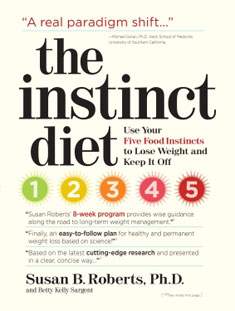Dieting by Instinct
Don’t fight your food impulses, says Tufts nutritionist Susan Roberts in a new book. What you need to do is work around them
By Julie Flaherty
Do weight-loss gurus ever agree on anything? The Atkins diet considers steak fit for losing weight, while the Ornish diet banishes meat. Everyone seems to have his own take on taking off the pounds.

“People tend to feel bad about lacking willpower, rather than accepting that natural biology is important when it comes to what we like to eat,” says Susan Roberts. Photo: Tracy Powell.
So a few years ago, Susan B. Roberts, a professor at the Gerald J. and Dorothy R. Friedman School of Nutrition Science and Policy, set out to see where the research concurs with the popular diet prescriptions. Her new book, The Instinct Diet (Workman), gets to the heart of what scientists really know about weight loss and puts a new spin on the idea of gut feelings.
She has come up with what she calls our five food instincts, which researchers agree on and which are borne out by cross-cultural comparisons. “When people get hungry, they want to eat. If there’s food there, you eat it. If it’s got calories, you like it more. If there is more variety, you eat more,” she says. “We keep ourselves safe by eating what we know under circumstances we know.”
Roberts’ approach is not to fight those instincts, but to use strategies to deal with them. She’s gleaned these approaches from the scientific literature and from 17 years studying people’s metabolisms, cravings, food preferences and responses to different diets as director of the energy metabolism laboratory at the Jean Mayer USDA Human Nutrition Research Center on Aging.
“People tend to feel bad about lacking willpower, rather than accepting that natural biology is important when it comes to what we like to eat,” Roberts says.

The Instinct Diet is filled with recipes, vegetarian options, quick-fix emergency meals, a supermarket navigator and a restaurant survival guide.
The Spice of Life
Take the urge for variety, which is supposed to ensure we take in a spectrum of nutrients. “Variety is an enormously underestimated component” of weight gain, she says. In one research study, for example, people who were offered three different shapes of pasta ate 14 percent more than those who were only served one shape.
But variety can also work to a dieter’s advantage. Her lab has shown that people who choose a greater range of vegetables end up doubling or tripling their vegetable consumption and reducing their calorie intake. The lesson? Limit yourself to one kind of cookie when you shop, but bring home a half-dozen different vegetables.
The desire for calorie-dense foods seems like a given. Who doesn’t love a rich dessert? But Roberts says it is not just your taste buds that enjoy that chocolate cake. When those calories get in your bloodstream, your brain releases addictive, feel-good chemicals like dopamine. After a while, your brain learns to “associate the rush of calories coming into the body with the tastes,” says Roberts, who is also an adjunct professor of psychiatry at Tufts Medical School.
So every time you see a chocolate cake, you desire it. She has seen it in her own lab, where people served two recipes with unfamiliar flavors eat them in equal amounts on the first day. Nine days later, the flavors they say they like are the ones associated with the calorie-dense recipe.
Roberts’ trick is to recalibrate the taste centers in our brains. “Our enjoyment of calories is relative,” she says. “We like what’s at the top end of our calorie scale. If you eat brownies with premium ice cream, and that’s the top end of your scale, low-fat salad is pretty unenticing. But if you add some oil to your salad and you serve a lower-calorie brownie with frozen yogurt, the calorie contents are more similar, so you can like the salad even though you still like the brownie.”
The Middle Path
Then there is hunger, a top reason for diet failure. Roberts says that studies point to four ways to keep satiated on fewer calories: eat foods high in volume, high in fiber, high in protein or low on the glycemic index (GI), which ranks carbohydrates according to their effect on our blood glucose levels. Low GI carbs—the ones that produce only small fluctuations in blood glucose and insulin levels—contribute to long-term health by reducing the risk of heart disease and diabetes and are key to sustainable weight loss.
But where other diet doctors may tout only one path, Roberts suggests picking and choosing. A high-fiber breakfast of whole grain cereal, milk and fruit is easy to prepare at home, but it’s hard to find high-fiber choices at restaurants, where it’s simple to order a high-protein meal of steak and veggies.
“One way doesn’t work for everybody,” she says. “You can tell people to eat high-protein diets, but they’ll get bored. You can tell them to eat low-glycemic-index diets, and they will find they haven’t got the patience to cook wheat berries. You can tell them to eat high volume, and they’ll be craving cheesecake. We have to give people options here.”
Roberts points out that the feeling of hunger, which is controlled by the hypothalamus, and reward, which is associated with the ventral striatum, both originate in the evolutionarily primitive center of the brain, where automatic functions like body temperature are controlled. That means you can decide with your prefrontal cortex whether to go into the Dunkin’ Donuts for coffee, but once inside, the sight and smell of the donuts can activate responses in your unconscious brain.
This plays into the instincts of availability (if the food is right in front of you, you want it) and familiarity (if a cruller with your coffee is a morning tradition, it will be harder to give up).
“When you can smell and see the donut you are used to eating, willpower often doesn’t work because it happens in the wrong part of the brain,” says Roberts. “What we have to do is lead our lives in ways that take willpower out of the equation.”
Julie Flaherty can be reached at julie.flaherty@tufts.edu.


